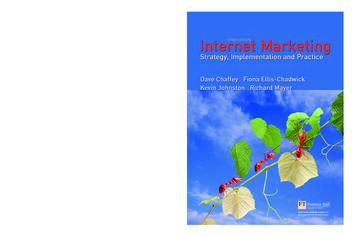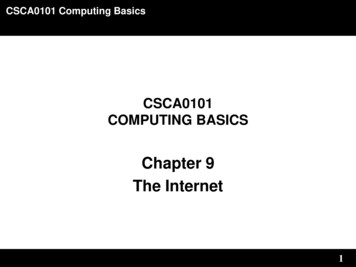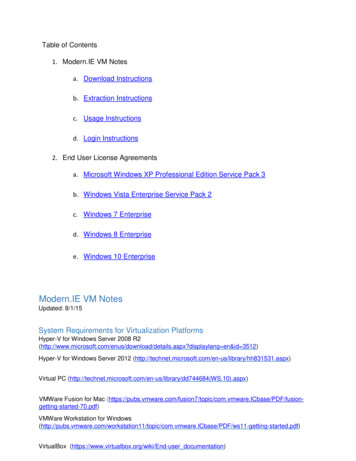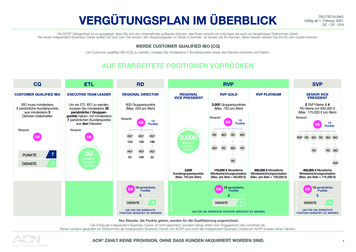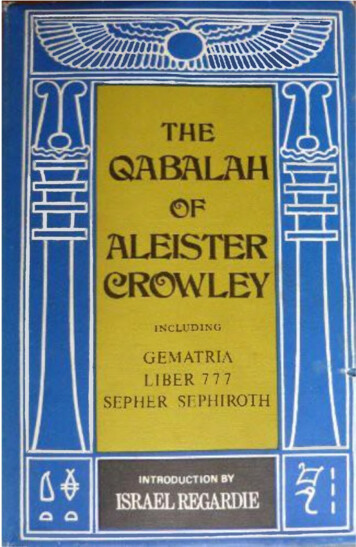
Transcription
INCLUDiNGGEM ATRIALIBER 777SEPHER SIPHIROTHINTRODUCTION BY
777AND OTHERQABALISTICWRITINGSOFALEISTERCROWLEY
777AND OTHERQABALISTIC WRITINGSOFALEISTER CROWLEYIncludingGEMATRIA & SEPHER SEPHIROTHEdited with an Introduction byISRAEL REGAR DIEThis book has been downloaded from Internet Archive: Digital Library andre-digitized for better reading and viewing. I hope this adds to your readingpleasure.SAMUEL WEISER, INC.York Beach, Maine
This collection first published asThe Qabalah of Aleister Crowley, 1973 bySamuel Weiser, Inc.P.O. Box 612York Beach, Maine 03910 Samuel Weiser, Inc., 1973Retitled in the fourth printing, 1977Reprinted 1979, 1982, 1983ISBN 0-87728-222-6Library of Congress Catalog Card No. 73-80056Printed in the U.S.A. byMaple-Vail Book Manufacturing GroupBinghamton, NY
CONTENTSINTRODUCTIONBOOK ONEGEMATRIA (Extrapolated from Equinox Vol. 1, No. 5)BOOK TWOLIBER 777*Editorial PrefacePrefaceviiix*A Brief Essay upon the Nature and Significance ofthe Magical Alphabetxvii*The Meaning of the Primes from 11 to 97xxvDiagram of the Tree of LifeSix Tables of Correspondencesxxvii1*Additional Tables37*Various Arrangements*Explanations of the Attributions in the moreimportant Columns of Table39*Appendix A. What is Qabalah?45125*Appendix B. What is a "Number" or a "Symbol"? 127Notes to Table of Correspondences138Appendix I. The Trigrams and Hexagrams of theYi King147* Indicates material not in the original edition.BOOK THREESEPHER SEPHIROTH (extrapolated from Equinox Vol. 1, No. 8)
: .a ,Y Wt.I%41t*it!Cj*v ,,:J'.Saida44dt3fC) 3I3'J10 -*
INTRODUCTIONThis is a unique collection of Qabalistic texts withoutparallel in the entire history of this vast mystical literature.All of them belong to the very early professional career ofAleister Crowley; that is they were written before he hadreached the age of 40 years. As every student of the Crowleycorpus of writings should know, however, they were usedconstantly and continuously by him throughout his lifetime.In the obscure footnotes to The Vision and The Voice(Sangreal Foundation, Dallas, 1972) which I recently edited,it soon became evident that few of those explanatory notesof his would make rhyme or reason to the average studentunless he were exceedingly well-grounded in the material andmethods delineated in those three books. All three need to bestudied assiduously over a long period of time before thosefootnotes become intelligible to any degree. Or until the intrinsic value of the texts themselves is perceived as being ofthe purest gold.The first of these three texts is actually one of the installments from the Equinox, the fifth, containing a biographicalserial entitled The Temple of King Solomon. This serial stroveto present a more or less dynamic picture of the personalityof Aleister Crowley or Frater Perdurabo, to use his Ordername, in the course of his progress along the mystical andmagical path. The first few installments were written by oneof his major disciples of the first decade of this century, Captain (later General) J. F. C. Fuller. After a while, these twomen separated, as narrated in The Confessions of AleisterCrowley (Hill & Wang, New York 1970). The result wasthat Crowley being left in the lurch, as it were, wrote thefifth installment as a kind of filler, enabling him to find timeto resume the narrative of his attainment interrupted by Fuller's departure.The "filler" has nothing to do, in reality, with the biographical narrative. It consisted of a set of Qabalistic and pragmatic notes on Number that Crowley had accumulated overthe years, and which he now tied together for this purpose.It consisted of a study of one phase of the Qabalisticprocess which is held in rather poor esteem today, mostly—so I believe—because the majority of modern writers havenot been able to penetrate its mystery. They cannot copewith it in any way. They regard it, unfortunately, on a par
with the common practice of numerology and fortune telling,thus missing the boat entirely.Gematria, as this process is named, is pronounced asg'mut'ree'ah. As a method it reminds me somewhat of themysteries surrounding the usage of the koan in the Rinzaisect of Zen. It seems at first sight nothing but perfect nonsense, this taking liberties with names and letters and numbers. But in point of fact, just as the koan is a meaningful butnot necessarily rational statement made from a mystical levelof consciousness, so also it may be used to induce a similartype of illumination in the determined student who uses it.Depending on the spiritual state of the reader, Gematria willbe perceived either as nonsense of the most grotesque description, or it will awaken some simulacrum of the mysticalstate originally experienced by its writer.If you study Crowley's exposition of the number 418, inthis second book Gematria, for example, something of thishigh point of view may he perceived. It was not arbitrarilychosen as an important or significant number for him, or forthat matter for anyone else. And so with many other numbers. The method does have a definite sphere of usefulnessand a vital place in Qabalistic exegetical process, but it doesrequire to be understood.Never for one moment suspect Crowley of gullibility ornaiveté. It may seem at first sight as if he were. But readthe first few pages of the essay on Gematria where you willnotice his satire, his ridicule, his humor. This should neverbe ignored or minimized. He never had difficulty pokingfun at himself or the methods he used for different purposes.It saved him from gullibility and credulity, the curse of theaverage occult student. Some of his conclusions on his numerical manipulations therefore are entitled, at the veryleast, to some scrutiny and examination, and this in turnmay lead to respect.For example, I have always been profoundly impressedby his handling of the number 913 (Equinox I, No. V, p.107). It is the gematria of Berashith, a Hebrew word meaning "the beginning", the first word of the Book of Genesis.He starts with a discussion of the number nine, and reducesit by several brilliant permutations and attributions to one,stating that "the many being but veils of the One; and thecourse of argument leads one to knowledge and worship of
each number in turn." In concluding the lengthy analysis,he does state explicitly that "9 is not equal to 1 for theneophyte. These equivalences are dogmatic, and only true byfavour of Him in whom All is Truth."Any man who can write thus of a subject which is taboobecause capable of infinite abuse, and which has earned thecontempt of several reasonable students of the mysteries, isworthy of respect and consideration.Right to the end of his days, Crowley felt that gematriawas a most useful tool, and tested many of his theoreticaland intuitive findings relative to The Book of the Law againstthe manipulations and inspirations of gematria. I must saythat I am in complete accord with him in this respect, as testified to by my earliest piece of writing A Garden of Pomegranates, in which there is a chapter on gematria.The second of these, Liber 777 has been reprinted several times in recent years. All of the new editions improvedon the first one, which is rare nowadays and most expensive,by the inclusion of many short essays and commentaries written at various times of Crowley, and added skillfully by theeditor after Crowley's demise in 1947.This book was first started in 1907 shortly after his returnfrom the China expedition. It is humorously referred to inthe second essay in Konx Om Pax where there are referencesto the Table of Correspondences in preparation. In pointof fact, these tables of correspondences which comprise Liber777 and which were not published until 1909, consist of basicinformation provided originally, piecemeal, in the knowledgelectures of the Hermetic Order of the Golden Dawn. Predicated on his own further studies and experiences, they wereenormously expanded by Crowley so that, at first sight, theybear little resemblance to the fragmented tables in the GoldenDawn.There is a wealth of valuable material here just waitingto be used. Many writers have done so without due acknowledgment.The book provides a basic system or method of filing newinformation on any topic and subject. The filing system ispredicated on a mere thirty two categories, the Ten Sephirothof the Tree of Life, and the twenty two letters of the HebrewAlphabet. Once this schema is understood, any new set ofdata of any kind can be referred to it, thus undergoing imme-
diate and spontaneous organization and synthesis within thepsyche. True, most of the material relates to comparativereligion and mythology, including precious stones, herbs andplants, and a multitude of other matters. Because these comprise the basic notions currently employed, one should notfeel limited only to these topics. At one time, I experimentedallocating the elements on the atomic scale to this Tree, withsome modicum of success. Somewhere along the line, in thecourse of my travels, this set of attributions has got lost, andI never made another attempt to duplicate it. It is mentionedhere, though, in the hope that enterprising students will realizethe enormous potentialities which lie ahead when using theTree of Life in this way.Liber 777 created a new type of literature when it firstappeared. It was the first of its kind, and Crowley deservescredit for that, even if some of the material itself is not original. The concept is, and that is all that matters.In order to get some theoretical idea of the Qabalah as aphilosophical schema, there are some modern books outsidethe Crowley corpus which could be consulted to considerableadvantage.First of all, there is Dion Fortune's masterpiece The Mystical Qabalah, which is similarly based on Golden Dawn material. Its value lies in the manner in which she has considered each item and each detail with an exposition which tiesthem all together intelligibly.Parallel to this is William Gray's Ladder of Lights, whichis another elucidation of the Tree from a different viewpointbut equally illuminating. Both of these books are limitedhowever merely to a study of the Ten Sephiroth, the maincategories of the Tree. Supplementing these is Gareth Knight'sPractical Course in Qabalistic Symbolism which extends thescope of the previous two books. By studying these threebooks, good background material should be provided fromwhich to learn to appreciate the enormously valuable taskperformed by Crowley in Liber 777 several decades ago.The student can accept as much or as little of the philosophydescribed in the above-named books as he wishes. It does notmatter, so long as the basic schema is understood and appliedto Liber 777. I foresee but little difficulty in this task.The third volume included here is Sepher Sephiroth, whichmeans simply the Book of Numbers. It is extrapolated from
Equinox I, No. 8. Originally, the book was started by AllanBennett, one of the Golden Dawn adepts who took Crowleyunder his wing to ground him in the fundamental processes ofMagic, Qabalah, and meditation. He must have been a mostextraordinary man, for his mark on Crowley proved to beindelible—and there are few for whom this may be said.Allan left one or two other pieces of writing 'which Crowley reproduced in one or other of the several volumes of theEquinox; they are worthy of being referred to. A Note onGenesis is a brilliant piece of exposition of Qabalistic principles demonstrating the whole gamut of Golden Dawn teachings, including some of the Qabalistic methods described here.For this reason alone it should be studied. The other waswritten after he had abandoned the Order to become a Buddhist monk with the sacramental name of the Bhikkhu AnandaMetteya. It is entitled The Training of the Mind, a study ofhow to acquire skill in meditation, one of the fundamentalsof the Buddhist way of life. Both essays show the fine calibreof his mind, demonstrating why Crowley was so profoundlyimpressed by him. Anyway—this book is due in large measure to his efforts which Crowley continued.Sepher Sephiroth consists of hundreds of Hebrew wordsselected from several sources that are listed in the front ofthe text. Most of the words are from the Old Testament anda couple of non-Zoharic texts translated by McGregor Mathersunder the title of The Kaballah Unveiled, from the Latin edition of Knorr von Rosenroth. These words were arrangedaccording to their numerical value by Bennett. The processand additional words were continued by Crowley after hehad inherited the book from his mentor.There are some strange gematria combinations to befound there, but it is traditionally assumed that if two wordshave the same number value, a connection of some kind maybe said to exist between them. At first sight, in some instances,no such relationship may be perceived, but if the student persists in his study and meditation, he may come to realizesomething of the profundities of these subtle connections andassociations that are not immediately perceived.I have taken the liberty of deleting a Table of Factor(Equinox I, No. 8, p. viii-xv), which in reality has nothingwhatsoever to do with Sepher Sephiroth.* In my opinion it is*This table is included by the publisher in the third edition, 1975
one of the occasional examples of Crowley's exhibitionism.Sometimes he just had to demonstrate his erudition. Much thesame is true of many numbers in the last few pages of thetext, (Equinox I, No. 8, p. 68-101) save for a few with theircorresponding Hebrew words that could be condensed andbrought closer together. These pages are omitted becausethere are no corresponding Hebrew words listed; for the timebeing they are just a waste of space and paper.While it is true that the serious student might study otherQabalistic texts and in the future discover new Hebrew wordshaving a numerical value that corresponds to those that Ihave just now deleted, nevertheless he could make his ownadditions to Sepher Sephiroth, insert a new string of numbersto make a place for his newly found words. And that is as itshould be. There should be nothing fixed or rigid about anyof these three books. They can be supplemented and expandedby the explorations of each student, depending on his ownjudgment and ingenuity. But he must not fall into the pitfallof some modern writers who, having no sympathy or understanding of the process, decry it and declare it of little valuein the Qabalistic scheme of things.I am also omitting Crowley's Preface to the book. It is anasty malicious piece of writing, and does not do justice tothe system with which he is dealing. Every so often, Crowleyfalls from the heights which he has seen, and swallows someone else's folly—someone whom he has had occasion toadmire. In this case, Sir Richard Burton, not always a whollyreliable authority—outside of The Arabian Nights.The essay on Gematria and Sepher Sephiroth should bestudied together. Some of the profundities of the first willnever be perceived until one has meditated long and often onsome of the words analyzed in that essay.I must confess that every now and again during the courseof my life I have experienced a thoroughgoing revulsion toCrowley as a person, resulting in the total rejection andneglect of what he has written.Days, weeks, months or years may elapse. Then "accidentally" I stumble across something he wrote—such asGematria and become so engrossed and enamored of his ingenuity and inspiration that my revulsion becomes almostimmediately transcended. This is probably more true of Gematria than either of the other two here included. (I am not
making reference to his other later writings or poetry or holybooks at this moment. They belong in a class by themselves.)The student who has missed the excitement and inner elevation experienced by Gematria—whether of his own makingor merely reading Crowley—has missed a very great deal.One scholar recently suggested to me in a letter that Crowley's knowledge of Hebrew was most limited. He made avery impressive "showing" only. In some ways, I am inclinedto agree. But on the other hand, what little he did know hehas used extremely effectively and creatively.Anyway, he was not a dull bluffer like Arthur EdwardWaite who pretended to all sorts of linguistic and scholasticskills he in fact never had. Take for example his book TheSecret Doctrine in Israel, which is a lengthy analysis of theZohar. That book was not written until after a French translation of the Zohar had been made—and of course long before the English one had appeared. The footnotes bear ampletestimony to this conclusion. Yet he pretended years priorto that book that his Latin and Hebrew were more than adequate to the task—though they were not. Even his Latintranslations of many alchemical texts were merely good editing jobs, the translators having been, amongst others, someelderly Anglican priests, preferring to remain if not anonymous then in obscurity, who had got mixed up with theGolden Dawn and the occult arts in general. They did the"donkey work" of translating difficult material, but Waitegot the glory and the swollen head. Whatever may be saidof Aleister Crowley's inflated ego—and I have often saidperhaps too much about this—he never stooped quite thatlow.All of this makes this book The Qabalah of Aleister Crowley of greater interest to the average good student whoseHebrew may be no better or no worse than that of Crowley.It may give him heart to pursue his own personal addendato those books and become as good a Qabalist as was Crowley.Finally, let me add that the student should own a goodHebrew-English lexicon. Perhaps one of the best ways ofusing this is to browse through it at random—casually as itwere, and then as his interest and excitement mount, lookfor certain words deliberately and methodically.For example. Open the lexicon at random, and on thatparticular page point carelessly to the first word noticed.
Transfer the word and its translation to a sheet of paper, andthen work out its gematria. Then turn to Sepher Sephirothto see if that number and word are represented. If not, addthem, using page inserts if necessary. Make special entriesof such words. As time proceeds, certain other words willevoke special interest and should be treated in the samemanner. Try to follow Crowley's analysis of l3erashith in theessay Gematria as a model for the management of thesewords, and as the basis for meditation to lead to the highest.Here are a couple of examples. I opened the lexicon atrandom and selected two words. A variety of Qabalisticmethods may be used to elaborate on them. Practice willproduce skill and insight.The first word selected was one meaning "empty." In Hebrew, it is spelled Nun, Ayin, Vav, Resh. Thus its gematriais: 50, 70, 6, 200 326. This is a number that is listed inSepher Sephiroth, and surprisingly is that of Yeheshuah, theRedeemer. The word for "vision" also comes within the purview of this number. Our lexicon word "empty" may seem afar cry from any of these words just mentioned, but . . . Seewhat a little meditation can do, after having followed a similar procedure to that used by Crowley relative to Berashith.Another word selected at random is "defect, or want."In Hebrew this is spelled Cheth, Samekh, Resh, Vav, finalNun. Its gematria comes to 324 (counting the Nun as 50).This, too, is another number already in Sepher Sephiroth.But it is worth comparing with the words already given there."Redness", "darkness", "roaring", etc. All three of theseQabalistic texts must be consulted to make sense of theseapparently unrelated words and numbers. The process thusbecomes a test for one's Qabalistic knowledge and skill, butmore importantly the process becomes a stimulus for thesurrender of the mind to the mystical experience in whichthe One is seen to be All, and vice versa.There are simply no limits to be set to the applications ofthese numerical processes. It will take only a little practiceand experience for the sincere and ingenious student to become aware of the possibilities inherent in gematria. And hewill conclude by developing a fine appreciation for the value—individually and collectively—of these three books assembled for the first time as The Qabaluh of Aleister Crowley.ISRAEL REGARDIE
GE-MATRIA
4 is ,1S.5S.5.S5. ';5. 444U:S.IS.:.,-5.,S,5.,5. ,5.55.4,5.,.-?1;45Si,;-1"'p,.sj4 ç5Pf '.'' ,!;.,sst44
GEMATRIAThis is taken verbatimfrom Aleister Crowley'sEquinox, Vol. 1, No. 5.It must first here be spoken of the Exoteric Qabalah to befound in books, a shell of that perfect fruit of the Tree of Life.Next we will deal with the esoteric teachings of it, as FraterP. was able to understand them. And of these we shall giveexamples, showing the falsity and absurdity of the uninitiated path, the pure truth and reasonableness of thehidden Way.For the student unacquainted with the rudiments of theQabalah we recommend the study of S. L. Mathers' " Introduction " to his translation of the three principal books of theZohar, and Westcott's "Introduction to the Study of theQabalah." We venture to append a few quotations from theI
former document, which will show the elementary principlesDr Westcott's little book is principallyof calculation.valuable for its able defence of the Qabalah as againstexotericism and literalism.The literal Qabalah . . . is divided into three parts: GMTRIA, Gematria;NVTRIQVN, Notariqon; and ThMVRH, Temura.Gematria is a metathesis of the Greek word ypa,u/aTe1a. It is based on therelative numerical values of words. Words of similar numerical values areconsidered to be explanatory of each other, and this theory is extended tophrases. Thus the letter Shin, Sh, is 300, and is equivalent to the numberobtained by adding up the numerical values of the letters of the words RVChALHIM, Ruach Elohim, the spirit of Elohim ; and it is therefore a symbol ofthe spirit of Elohim. For R 2oo, V 6, Ch 8, A i, L 3o, H 5, I .io,M 40; total 300. Similarly, the words AChD, Achad, Unity, One, andAHBH, Ahebah, love, each i; for A i, Ch 8, D 4, total 13; and A i,B 2, H 5, total 13. Again, the name of the angel MTTRVN,Metatron or Methraton, and the name of the Deity, ShDI, Shaddai, each make314; so the one is taken as symbolical of the other. The angel Metatron issaid to have been the conductor of the children of Israel through the wilderness,of whom God says, " My name is in him." With regard to Gematria of phrases(Gen. xlix. io), IBA ShILH, Yeba Shiloh, "Shiloh shall come " 358, which isthe numeration of the word MShICh, Messiah. Thus also the passage,Gen. xviii. 2, VHNH ShLShH, Vehenna Shalisha, ' And lo, three men," equalsin numerical value ALV MIKAL GBRIAL VRPAL, Elo Mikhael Gabriel VeRaphael, "These are Mikhael, Gabriel and Raphael"; for each phrase 701. Ithink these instances will suffice to make clear the nature of Gematria.Notariqon is derived from the Latin word notarius, a shorthand writer. OfNotariqon there are two forms. In the first every letter of a word is taken fromthe initial or abbreviation of another word, so that from the letters of a worda sentence may be formed. Thus every letter of the word BRAShITH,Berashith, the first word in Genesis, is made the initial of a word, and we obtainBRAShITh RAH ALHIM ShIQBLV IShRAL ThVRH. Berashith RahiElohim Sheyequebelo Israel Torah; "In the beginning Elohim saw that Israelwould accept the law." In this connection I may give six very interestingspecimens of Notariqon formed from this same word BRASh ITh by SolomonMeir Ben Moses, a Jewish Qabalist, who embraced the Christian faith in 1665,and took the name of Prosper Rugere. These have all a Christian tendency,2
and by their means Prosper converted another Jew, who had previously beenbitterly opposed to Christianity. The first is, BN RVCh AB ShLVShThMIChD ThMIM, Ben, Ruach, Ab, Shaloshethem Yechad Thaubodo: "TheSon, the Spirit, the Father, ye shall equally worship Their Trinity." The thirdis BKVRI RAShVNI AShR ShMV IShVO ThOBVDV, Bekori RashuniAsher Shamo Yeshuah Thaubodo: "Ye shall worship My first-born, My first,Whose name is Jesus." The fourth is, BBVA RBN AShR ShMV IShVoThOBVDV, Beboa Rabban Asher Shamo Yeshuah Thaubodo: "When theMaster shall come Whose Name is Jesus ye shall worship." The fifth is,BThVLH RAVIH ABChR ShThLD ISh VO ThAShRVH, Bethulh RaviahAbachar Shethaled Yeshuah Thashroah: "I will choose a virgin worthy tobring forth Jesus, and ye shall call her blessed." The sixth is, BOVGThRTzPIM ASThThR ShGVPI JShVO ThAKLV, Beaugoth Ratzephim AsattarShegopi Yeshuah Thakelo: " I will hide myself in cake (baked with) coals, forye shall eat Jesus, My Body."The Qabalistical importance of these sentences as bearing upon the doctrinesof Christianity can hardly be overrated.The second lorm of the Notariqon is the exact reverse of the first. By thisthe initials or finals, or both, or the medials, of a sentence, are taken to form aword or words. Thus the Qabalah is called ChKMH NSThRH, ChokhmahNesethrah, 'the secret wisdom "; and if we take the initials of these two wordsCh and N, we form by the second kind of Notariqon the word ChNChen, "grace." Similarly, from the initials and finals of the words MIIOLH LNV HShMIMH, Mi Iaulah Leno Ha-Shamayimah, "Who shall go upfor us to heaven?" (Deut. xxx. 12), are formed MILH, Milab, "circumcision,"and IHVH, the Tetragrammaton, implying that God bath ordained circumcisionas the way to heaven.Temura is permutation. According to certain rules, one letter is substitutedfor another letter preceding or following it in the alphabet, and thus from oneword another word of totally different orthography may be formed. Thus thealphabet is bent exactly in half, in the middle, and one half is put over theother; and then by changing alternately the first letter or the first two lettersat the beginning of the second line, twenty-two commutations are produced.These are called the ' Table of the Combinations of TzIRVP," Tziruph. Forexample's sake, I will give the method called ALBTII, Albath, thusII1082i649735K I T Ch Z V II D G B AM N S 0 1' Tz Q R Sh Tb LEach method takes its name from the first two pairs composing it, the system3
of pairs of letters being the groundwork of the whole, as either letter in apair is substituted for the other letter. Thus, by Albath, from RVCh, Ruach,is formed DTzO, Detzau. The names of the other twenty-one methods are:ABGTh, AGDTh, ADBG, AHBD, AVBH, AZBV, AChBZ, ATBCh, AIBT,AKBI, ALBK, AMBL, ANBM, ASBN, AOBS, APBO, ATzBP, AQSTz,ARBQ, AShBR, and AThBSh. To these must be added the modes ABGDand ALBM. Then comes the "Rational Table of Tziruph," another set oftwenty-two combinations. There are also three "Tables of the Commutations,"known respectively as the Right, the Averse, and the Irregular. To makeany of these, a square, containing 484 squares, should be made, and the letterswritten in. For the "Right Table" write the alphabet across from right toleft; in the second row of squares do the same, but begin with B and endwith A; in the third begin with G and end with B; and so on. For the"Averse Table" write the alphabet from right to left backwards, beginningwith Th and ending with A; in the second row begin with Sh and endwith Th, &c. The "Irregular Table" would take too long to describe. Besidesall these, there is the method called ThShRQ, Thashraq, which is simplywriting a word backwards. There is one more very important form calledthe "Qabalah of the Nine Chambers" or AIQ BKR, Aiq Bekar. It is thusformed:300Sh30L3G600Mfinal6oS6VK final90090Tz finalTz9TP N final7007Z800I have put the numeration of each letter above to show the affinity betweenthe letters in each chamber. Sometimes this is used as a cipher, by takingthe portions of the figure to show the letters they contain, putting one point forthe first letter, two for the second, &c. Thus the right angle, containingAIQ, will answer for the letter Q if it have three dots or points within it.Again a square will answer for H, N, or K final, according to whether ithas one, two, or three points respectively placed within it. So also withregard to the other letters. But there are many other ways of employingthe Qabalah of the Nine Chambers, which I have not space to describe. Iwill merely mention as an example, that by the mode of Temura called4
AThBSh, Athbash, it is found that in Jeremiah xxv. 26, the word ShShK,Sheshakh, symbolises BBL, Babel.Besides all these rules, there are certain meanings hidden in the shapeof the letters of the Hebrew alphabet ; in the form of a particular letter atthe end of a word being different from that which it generally bears whenit is a final letter, or in a letter being written in the middle of a word in acharacter generally used only at the end ; in any letters or letter being writtenin a size smaller or larger than the rest of the manuscript, or in a letterbeing written upside down ; in the variations found in the spelling of certainwords, which have a letter more in some places than they have in others; inpeculiarities observed in the position of any of the points or accents, andin certain expressions supposed to be elliptic or redundant.For example the shape of the Hebrew letter Aleph, A, is said to symbolisea Vau, V, between a Yod, 1, and a Daleth, D ; and thus the letter itselfrepresents the word IVD, Yod. Similarly the shape of the letter He,H, represents a Daleth, D, with a Yod, I, written at the lower left-handcorner, &c.In Isaiah ix. 6, 7, the word LMRBH, Lemarbah, "for multiplying," iswritten with the character for M final in the middle of the word, instead ofwith the ordinary initial and medial M. The consequence of this is that thetotal numerical value of the word, instead of being 30 40 200 2 5 277, is30 600 200 2 5 8 37 by Gematria ThTh ZL, Tet Zal, the profuse Giver.Thus by writing the M final instead of the ordinary character, the
lectures of the Hermetic Order of the Golden Dawn. Predi-cated on his own further studies and experiences, they were enormously expanded by Crowley so that, at first sight, they bear little resemblance to the fragmented tables in the Golden Dawn. There is a wealth of valuable material here just waiting to be used.
